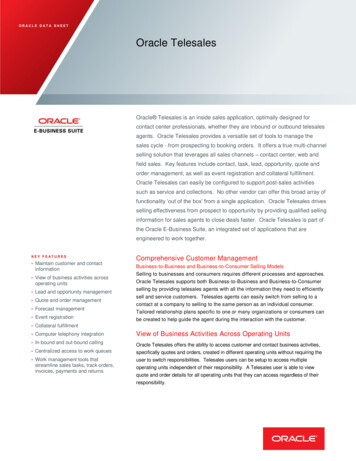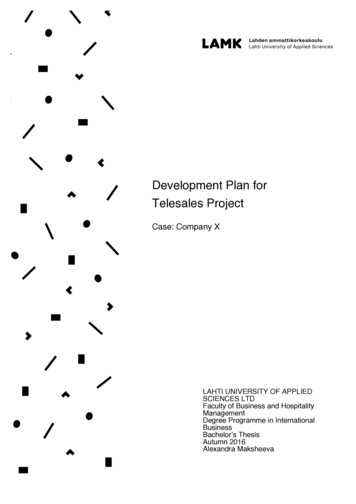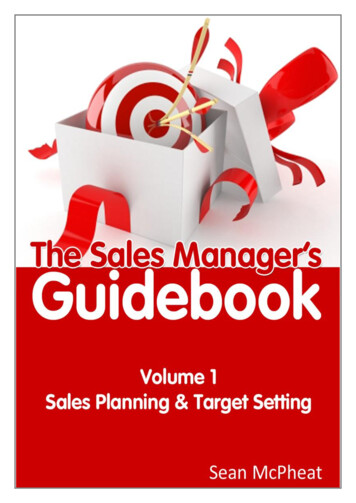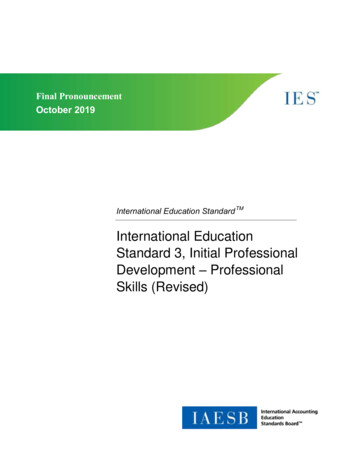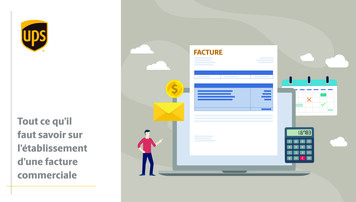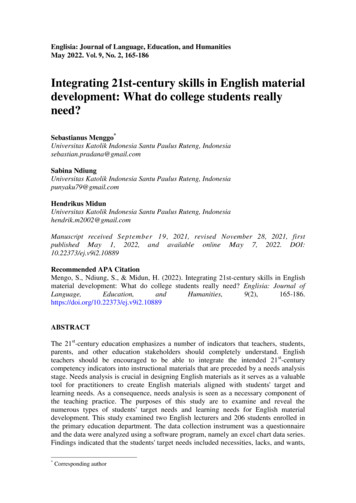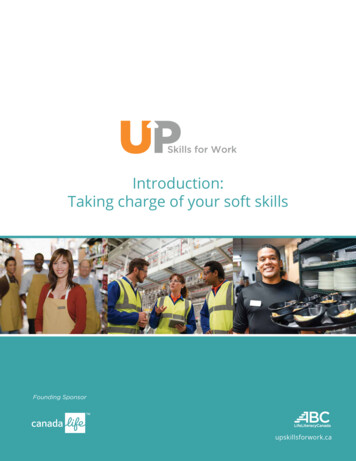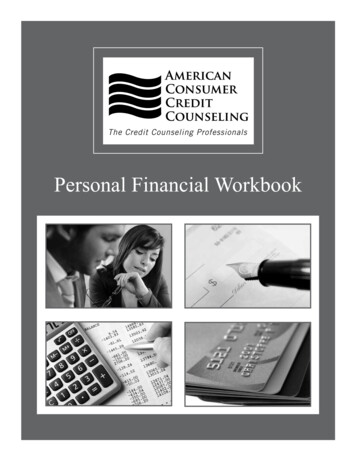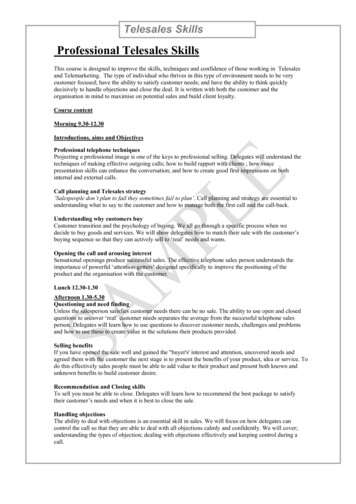
Transcription
Telesales SkillsProfessional Telesales SkillsThis course is designed to improve the skills, techniques and confidence of those working in Telesalesand Telemarketing. The type of individual who thrives in this type of environment needs to be verycustomer focused; have the ability to satisfy customer needs; and have the ability to think quicklydecisively to handle objections and close the deal. It is written with both the customer and theorganisation in mind to maximise on potential sales and build client loyalty.Course contentMorning 9.30-12.30Introductions, aims and ObjectivesProfessional telephone techniquesProjecting a professional image is one of the keys to professional selling. Delegates will understand thetechniques of making effective outgoing calls; how to build rapport with clients ; how voicepresentation skills can enhance the conversation; and how to create good first impressions on bothinternal and external calls.Call planning and Telesales strategy‘Salespeople don’t plan to fail they sometimes fail to plan’. Call planning and strategy are essential tounderstanding what to say to the customer and how to manage both the first call and the call-back.Understanding why customers buyCustomer transition and the psychology of buying. We all go through a specific process when wedecide to buy goods and services. We will show delegates how to match their sale with the customer’sbuying sequence so that they can actively sell to ‘real’ needs and wants.Opening the call and arousing interestSensational openings produce successful sales. The effective telephone sales person understands theimportance of powerful ‘attention-getters’ designed specifically to improve the positioning of theproduct and the organisation with the customer.Lunch 12.30-1.30Afternoon 1.30-5.30Questioning and need findingUnless the salesperson satisfies customer needs there can be no sale. The ability to use open and closedquestions to uncover ‘real’ customer needs separates the average from the successful telephone salesperson. Delegates will learn how to use questions to discover customer needs, challenges and problemsand how to use these to create value in the solutions their products provided.Selling benefitsIf you have opened the sale well and gained the "buyer's' interest and attention, uncovered needs andagreed them with the customer the next stage is to present the benefits of your product, idea or service. Todo this effectively sales people must be able to add value to their product and present both known andunknown benefits to build customer desire.Recommendation and Closing skillsTo sell you must be able to close. Delegates will learn how to recommend the best package to satisfytheir customer’s needs and when it is best to close the sale.Handling objectionsThe ability to deal with objections is an essential skill in sales. We will focus on how delegates cancontrol the call so that they are able to deal with all objections calmly and confidently. We will cover;understanding the types of objection; dealing with objections effectively and keeping control during acall.
TELEPHONE SELLING: CONTENTS2.The Power of the Telephone5.Lifetime Value of Your Average Customer9.Improving the Power of the Voice11.Inner Dialogue13.Effective Communication14.Planning the Call20.Telephone Sales Contact Strategy22.Understanding Why Customers Buy?24.Opening the Call and Arousing Interest26.Stages of Effective Introduction29.Qualifying the Client30.Uncovering the Customer’s Needs36.The Art of Listening38.Selling Benefits45.Closing the Customer52.Methods of Overcoming Resistance58.Worksheet59.Making a Quality Appointment60.Appointment Making62.Analysing the Call Afterwards63.Action Plan64.Notes65.Course Evaluation Form
PROFESSIONAL TELEPHONE TECHNIQUESCommunication is a two way processInformation is a one-way processThe phone is probably the most used tool in modern business. 25 million business-to-businesscalls are made every day in the UK (Source: BT). Not everyone admits to being confident ortotally proficient in their use of the phone so it is worth looking at why phone skills are vital foreffective business communication. This is largely because it is a (relatively) cheap and efficientway of contacting many customers in a short period of time, giving information quickly andeffectively and receiving instant answers and hopefully sales.The modern telemarketer must remember that the phone communication is different from faceto-face communications and must adapt their communication to maximise on the potential thephone gives us.As we deal with customers over the telephone, we need to remember that:1. It is a substitute for face-to-face conversations. Therefore we need to work at findingways to compensate for what we are missing out on: we cannot see facial expressions, manners, reactions we cannot see what the other person is doing we cannot lip-read what the other person is saying we cannot use illustrations to help them understandIn fact, the only sense we can use is hearing - the one that requires the most concentration! Wemust speak clearly to ensure our communication is fully understood by the customer. The phonecreates a temporary disability because the customer can’t see what’s happening on the other side;they are therefore more likely to be confused by poor communication and frustrated by calls thatmay be perceived as ‘wasting their time’.2.Many customers feel uncomfortable using the telephone. They may feel threatened bythe speed and conclusiveness of a telephone call - it's over before they've finishedcollecting their thoughts. A phone call is on average 20% quicker than a face to faceconversation because we don’t have the visual element to slow down the conversationwhen, for example the salesperson is looking up some information on the computer.Many sales are lost because the customer felt pressured to make a decision withoutknowing the full facts.3.Four important factors of telephone Customer Service. Customer service is essentialin tele-selling. No one likes to be sold something by someone with the ‘gift of the gab’.They may come across as flippant and uncaring. We like to feel that the sales personcares about our needs and is looking to satisfy them with their products. Our customerspay extra attention to the four factors below, to compensate for not being able to seewhat’s going on: Promptness - How quickly we can resolve the customer’s current problem;managing the customer’s expectations by giving deadlines of delivery and easeof service.Courtesy - Being polite and making the customer feel valued; giving reasons forall actions/instructions and using courtesy language; please, thank you etc.Organisation - Having sufficient product knowledge to deal effectively with thecustomer’s questions, queries or complaints.
Helpfulness - Showing a willingness to deal with and resolve any issues thecustomer voices. To quickly produce actions that satisfy not confuse. A pleasant,helpful tone of voice is very important to let the customer know that you wish tohelp them.These are not the only factors that create good Customer Service during the sales process. Youmust also remember that the customer is more likely to put the phone down if they feeldissatisfied by the service they received. The basic fact about telesales is WHEN THE PHONEIS PUT DOWN - THE SALE IS OVER.Other factors affecting your phone effectiveness Part of the message may be lost because visual communication is absent. Youmay be distracted, and then not give your whole attention directly to thecustomer. You therefore risk losing vital parts of information which make up thewhole message.The fact that the connection may be poor means that it may be difficult to hearall that is said by yourself or the customer; this can cause distraction andirritation.Your environment can greatly affect the quality of your phone communication,especially if it is noisy or there are distractions.The subject matter (which may be private or sensitive) may be received in asituation where the recipient does not want to speak openly.If a call is taken from a customer when you are in the middle of something thatcan be continued during the call, e.g. typing, you may give more attention to thatthan to the customer. The customer may realise that your attention is not fully onthem.The customer is annoyed at the inconvenience of the timing of the call. This isespecially relevant if you are calling them on their mobile phone when they aredriving or in a meeting.The recipient may feel hostility towards the caller which prevents the messagegetting through or there may be an unwillingness to accept what is being said.There may be unwillingness by the recipient to accept the speed at which he/sheis being asked by the caller to make a decision.Jargon is used by the salesperson that may alienate potential customers who arenot used to it.People are very receptive to advertising messages but most would claim to be wary of telephoneselling or telemarketing. If we were to look at the differences between phone marketing andtelevision advertising we may be able to understand: the challenges which people facewhy there is a reluctance to buy over the telephoneCOMMERCIALSThe difference of our perception between T.V./radio advertising and direct sales We ‘invite’ adverts into our homes both the programmes and the advertisingWe are in control as we have the on/off switchMany ads are mini-programmes and have an appeal and entertainment valueWe appreciate the creativity in many adsWe need no direct input
The advertiser has a direct interest in trying to create demand for their products from theviewerBecause of the cost of the ads, this infers that the product must be of good valueFew adverts last that insult the intelligence of the viewerTHE SALES CALL MUST THEREFORE: minimise any inconvenience to the customer, i.e. “Do you have a few minutes to discuss howour product can help you?” contain an interest which does not insult the intelligence contain a degree of creativity which entices be conducted by someone who understands what they are doing show understanding and appreciation of the low regard with which many cold calling operations areheld show value to the customer that their time isn’t being wastedRemember again: WHEN THE PHONE IS PUT DOWN - THE SALE IS OVER.EXERCISEBased on the factors above, what could you do to improve your Telephone Service Behaviour?Split into groups and discuss how you could improve your telephone selling and service skills.Each group will elect a spokesperson who will deliver the group’s findings to everyone.To be more effective Telephone Sales Professionals we need to:. .
TELEPHONESELLINGCOURSE INSTRUCTIONS
Trainer’s Key Points and GlossaryEXERCISEExercises for delegates - these may incorporate HOs or Manualreferences.FlipchartTrainer can use this at their discretion. This will allow an additionalinteractive element to your training.HOHandout(s) - these are numbered in sequence, no.1 We have also included Optional HOs and they are numbered insequence, a. We find HOs are an important element of training, as this allowsyou to interact with your group, and to add interactive elements toyour training.ManualTraining Manual – the Course Instruction’s Directions will makereference to what page is required in the Manual.The manual is a useful reference tool for the trainer but also givesimpact to your training as you will be giving your delegatessomething substantial to take away with them.Manual SequenceContent Page Page no. 1TIP: When printing your manual, pg. 0 is your title page.Optional SessionsIf you have a smaller group, or they have specific requirements, usethe optional session(s).Role-PlayTrainer to separate delegates into groups and allow them sufficienttime to act out a role-play scenario(s). Depending on yourrequirements, you can ask one/ all group(s) to relay their role-playto the rest of the group.SlidePresentation slide - the Course Instruction’s Directions will makereference to what number Slide is required within your trainingpresentation. Slide no.1 is your title Slide.Slide SequenceIntroduction/ Title Slide Slide no.1Special InstructionsUse this for additional information, or for tips that the trainer mayfind useful.TimingsThe timings are as a guide only, and will depend on the group sizeand their requirements.Disclaimer:The contents of this training pack are supplied to third parties for the purpose of training. The information contained is forguidance only. Total Success Training Ltd, and the employees of Total Success Training Ltd shall not be held responsible forthe actions of anyone who uses this, or has been trained with any of the contents contained in any section of the course.
Session 1Welcome, introductions, aims and objectivesActionRequired1.1Introduce yourself; your training credentials and expertise on the particular subject.Explain any housekeeping rules, lunch, breaks and timings etc. Show delegatescourse objectives and agenda for the day.Slide 1-6 /Manual pg.55 /Flipchart1.2Discuss course objectives and guidelines and emphasising that participation isessential for a good course1.3EXERCISE 1: Delegates to complete questions on ‘Delegate Information’, Slide 6 Allow 5 minutes; Each delegate to share the information. Trainer to note their courseobjectives on Flipchart.1.4Issue Course Manual - show ‘Post-Course Action Plan’, Manual pg.55. Emphasisethe importance of completing this throughout the training to highlight to delegatesany areas of improvement required.Timing 30 minutesSPECIAL INSTRUCTIONS FOR PRE-COURSE BRIEFINGPre-course Briefing and Questionnaire (Handout 1): We recommend that these are issued at least a week prior to atraining course. They allow delegates to think through and discuss with their line managers the reasons why they areattending the course and what they are looking to achieve from the training. Ask delegates to bring them completed tothe course; they are useful in discussing the delegate’s objectives during the Introduction to the training. Write down alldelegate’s objectives on a flip chart or whiteboard and refer back to them at the end of the course to see if the objectiveswere met.
Manual Training Manual - the Course Instruction's Directions will make reference to what page is required in the Manual. The manual is a useful reference tool for the trainer but also gives impact to your training as you will be giving your delegates something substantial to take away with them. Manual Sequence Content Page Page no. 1
